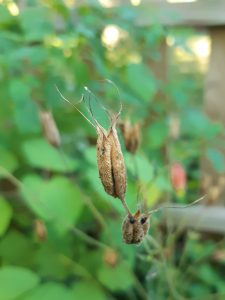Seed Collecting
By Laura Walther Schaefer
Fall is often the season when seed collecting comes to mind, but waiting until then means likely missing many of the spring to early summer flowers that have either finished their seed-producing cycle or are about ready for harvest now. Collecting your own seed, as opposed to buying plants from a nursery, means getting a greater genetic diversity from locally grown plants that are best suited to their local conditions. Plants from nurseries are more often clones of one another, which means they are all exactly the same genetically. Genetic diversity increases resiliency against varying weather conditions and diseases. It increases the likelihood of survival, which helps to perpetuate genes that are best fit to their environment. This genetic diversity is also good for the pollinators and therefore the ecosystem as a whole.
It is best to collect seeds on a sunny and dry day in the afternoon when dew has had a chance to evaporate. Only collect from seed pods or seeds that have reached full maturity. A fully mature seed, seed head or pod is typically fully mature when it is grey, brown, tan or black and dry and crunchy to the touch. Likewise, seeds are typically mature when they are also grey, tan, brown or black. The Columbine seed pods pictured are tan and their seeds are black. In addition, the pod has begun to split open indicating the seeds are ready for dispersal. Now is the right time to collect.
I like to collect seeds in paper bags. If you’re not sure if the seed is fully dry, they can be temporarily stored in them until dry. Store seeds in labeled paper envelopes, clean pill bottles or glass jars. I like to collect the silica packets from various goods for reuse. I put one silica packet in each jar of seeds. This helps to keep them dry and from going bad. In addition, store your envelopes or containers in a dark, dry and cool location to increase seed longevity.

Native plant seeds that are ready now, or soon will be, include spring and early summer flowers, such as Columbine, Lanceleaf Coreopsis, Golden Ragwort, Golden and Heartleaf Alexander, Wild Indigos, Wild Hyacinth, Virginia and Great Waterleaf, Bellwort, Solomon’s Seal and Plume, Sweet Cicely, Aniseroot, Woodland Phlox, Wild Geranium, Buttercups and Wild Violets, among others. Make sure to look up when the best time is for sowing these seeds. Some seeds will need to be planted late fall or early winter in order to germinate. Remember that it is illegal to collect seeds or plants from nature preserves and many other public and private lands. If it isn’t your property, make sure you have permission to harvest.
If you don’t have a source for wildflower seed near you, SWIC Biology Instructor, Laura Schaefer, will be leading a prairie walk at Clifftop’s Paul Wightman Subterranean Nature Preserve, 3325 G Road, Fults, on August 20th and a seed collecting walk on September 17th at 9am along the 1 mile, ADA accessible, walking trail. Meet at the pavilion. Dress for the weather and bring a drink to stay cool and hydrated.
CLIFFTOP, a local nonprofit organization, is focused on preserving and protecting area bluff lands.
A version of this article appeared in the July 20, 2022 edition of the Republic-Times.
Comments are currently closed.
